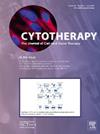Development of Frozen-thawed Allogenic Fibroblast Sheets for Esophageal Anastomotic Leakage
IF 3.2
3区 医学
Q2 BIOTECHNOLOGY & APPLIED MICROBIOLOGY
引用次数: 0
Abstract
Background & Aim
Gastrointestinal anastomotic leakage is a severe postoperative complication, and its effective preventive measures remain unestablished. We have developed allogeneic multilayered fibroblast sheets, which promote wound healing in various organs. When considering clinical applications, the cryopreserved cell sheets can be transplanted immediately after thawing. However, frozen-thawed allogenic fibroblast sheets have not been investigated for gastrointestinal anastomotic leakage. This study examined the prevention of anastomotic leakage by transplanting frozen-thawed allogeneic multilayered fibroblast sheets into an esophageal anastomosis model.
Methodology
Multilayered fibroblast sheets were prepared by culturing the oral mucosa of Sprague–Dawley rats for 9 days. The esophageal anastomosis model was established by transecting the esophagus of Wistar/ST rats and performing reanastomosis with three-point interrupted sutures. The multilayered fibroblast sheets were cryopreserved in an ultralow temperature freezer after freezing in a three-dimensional freezer. The rats were categorized into the control (suture only) and fibroblast sheet groups (in which two fibroblast sheets were transplanted) (Fig. 1). The incidence of anastomotic leakage and burst pressure was evaluated 3 and 5 days after transplantation. Furthermore, growth factors secreted by the fibroblast sheets and the collagen expression levels in the tissue were assessed.
Results
The incidence of anastomotic leakage was significantly lower in the fibroblast sheet group (allogeneic multilayered fibroblast sheet transplantation) than in the control group (suture only) (Table 1).Furthermore, the burst pressure was significantly higher in the fibroblast sheet group than in the control group (day 5: 78 ± 26 mmHg vs 124 ± 30 mmHg; p < 0.01).The mRNA expression level of type I collagen 5 days postoperatively was significantly higher in the fibroblast sheet group than in the control group (control group: 8.35 ± 3.77 vs cell sheet group: 19.58 ± 10.28; p = 0.05). Additionally, the quantitative analysis of type I collagen 5 days postoperatively revealed significantly higher levels in the fibroblast sheet group than in the control group (control group: 0.09 ± 0.04 μg vs fibroblast sheet group: 0.14 ± 0.03 μg; p = 0.04).
Conclusion
The transplantation of frozen-thawed allogeneic multilayered fibroblast sheets reduced the incidence of anastomotic leakage and burst pressure, indicating their potential to help prevent esophageal anastomotic leakage.
冻融同种异体成纤维细胞片治疗食管吻合口瘘的研究
背景,胃肠道吻合口瘘是术后严重的并发症,有效的预防措施尚未建立。我们已经开发了异体多层成纤维细胞片,促进不同器官的伤口愈合。当考虑临床应用时,冷冻保存的细胞片可以在解冻后立即移植。然而,冷冻解冻的同种异体成纤维细胞片尚未被研究用于胃肠道吻合口瘘。本研究探讨了将冷冻解冻的同种异体多层成纤维细胞片移植到食管吻合模型中对吻合口漏的预防作用。方法采用Sprague-Dawley大鼠口腔黏膜培养9 d制备多层成纤维细胞片。取Wistar/ST大鼠食管横切,采用三点间断缝合线进行再吻合,建立食管吻合模型。多层成纤维细胞片在三维冷冻室中冷冻后,在超低温冷冻室中冷冻保存。将大鼠分为对照组(仅缝合)和成纤维细胞片组(移植两组成纤维细胞片)(图1)。术后3、5天观察吻合口瘘发生率和破裂压力。进一步观察成纤维细胞片分泌的生长因子和组织中胶原蛋白的表达水平。结果成纤维细胞片组(同种异体多层成纤维细胞片移植)吻合口漏发生率明显低于对照组(仅缝合)(表1)。此外,成纤维细胞片组的破裂压力明显高于对照组(第5天:78±26 mmHg vs 124±30 mmHg;p & lt;0.01)。术后5 d,成纤维细胞片组I型胶原mRNA表达量显著高于对照组(对照组:8.35±3.77 vs细胞片组:19.58±10.28; = 0.05页)。此外,术后5 d定量分析显示,成纤维细胞片组I型胶原水平显著高于对照组(对照组:0.09±0.04 μg vs成纤维细胞片组:0.14±0.03 μg; = 0.04页)。结论冻融同种异体多层成纤维细胞片移植可降低吻合口瘘发生率和破裂压力,具有预防食管吻合口瘘的作用。
本文章由计算机程序翻译,如有差异,请以英文原文为准。
求助全文
约1分钟内获得全文
求助全文
来源期刊

Cytotherapy
医学-生物工程与应用微生物
CiteScore
6.30
自引率
4.40%
发文量
683
审稿时长
49 days
期刊介绍:
The journal brings readers the latest developments in the fast moving field of cellular therapy in man. This includes cell therapy for cancer, immune disorders, inherited diseases, tissue repair and regenerative medicine. The journal covers the science, translational development and treatment with variety of cell types including hematopoietic stem cells, immune cells (dendritic cells, NK, cells, T cells, antigen presenting cells) mesenchymal stromal cells, adipose cells, nerve, muscle, vascular and endothelial cells, and induced pluripotential stem cells. We also welcome manuscripts on subcellular derivatives such as exosomes. A specific focus is on translational research that brings cell therapy to the clinic. Cytotherapy publishes original papers, reviews, position papers editorials, commentaries and letters to the editor. We welcome "Protocols in Cytotherapy" bringing standard operating procedure for production specific cell types for clinical use within the reach of the readership.
 求助内容:
求助内容: 应助结果提醒方式:
应助结果提醒方式:


